The Electronic Intifada 4 February 2009

Food distribution at a UN center in Deir al-Balah, central Gaza Strip, February 2009. (Hatem Omar/MaanImages)
UNITED NATIONS (IPS) - The United Nations is urgently appealing for 613 million dollars to aid more than a million desperate civilians in the ruins of Gaza, where schools, hospitals, houses, factories and even farmland were obliterated during the three-week assault by Israeli air and ground forces.
At least 1,300 Palestinians were killed and more than 5,300 injured in the war, according to the Palestinian Ministry of Health. Some 21,000 homes were reported destroyed or badly damaged, and more than 50,000 people were displaced into temporary UN shelters.
“Whole industrial areas [were] completely flattened, buildings blasted into piles of rubble,” Christine van Nieuwenhuyse, the World Food Programme’s (WFP) country director for the occupied Palestinian territories, reported after her recent trip to Gaza.
“While there were some areas left totally untouched, it was precisely the strategic economic areas that Gaza depends on to relieve its dependency on aid that were wiped out,” she wrote.
John Holmes, the UN’s emergency relief coordinator, noted that the funding appeal is for a nine-month period only, to cover immediate emergency aid and essential repairs. “Longer-term reconstruction is a separate issue which will be addressed separately,” he added.
In fact, the total cost to rebuild Gaza is estimated at about 2 billion dollars. Saudi Arabia has already said it would donate 1 billion dollars, with the rest to be raised at a donors’ conference hosted by Egypt on 2 March.
The largest sums of the UN emergency appeal will go to food security (153 million), shelter items and non-food items (119 million) and cash assistance programs (92 million).
Thirty million dollars would be spent on rehabilitating agricultural production. Daly Belgasmi, the WFP’s regional director for the Middle East, Central Asia and Eastern Europe, stressed at a press conference here that “the goal is not to create a society of assisted people, but rather people who are responsible for themselves.” Engaging farmers is one important way to do this, he added.
Holmes identified three factors as critical to the success of the relief effort. “The first most obvious one is that the current unilateral fragile ceasefires be stabilized and made into a durable ceasefire so that we have a reasonably peaceful environment in which to operate,” he said.
“The second, and this is crucial also, is much freer access for humanitarian goods, commercial goods, humanitarian staff, people in general, and also last but not least, cash as the economy cannot function without cash.”
The third requirement is to be able to conduct relief operations free from political interference, he said.
The operation needs the cooperation of Israeli authorities, since they control the crossing points, while the Palestinian Authority still pays many of the civil servants in Gaza and must be closely involved as well.
Where aid workers need to deal with Hamas at the technical level, they will have no hesitation in doing so, Holmes added.
The complex relief effort on the ground is being carried out by more than a hundred non-governmental organizations and dozens of UN agencies and programs.
“The European Union, non-governmental organizations, European Commission, World Bank and other partners are members of the early recovery cluster and work in a coordinated and systematic manner to support the Palestinians in the aspiration to recover livelihoods, address post-war trauma, restore basic social services and utilities, provide shelter, restore productive assets and capacities, etc.,” Jens Toyberg-Frandzen of the UN Development Program told IPS.
He said that the reconstruction process includes an initial humanitarian relief phase, early recovery phase and post-conflict recovery phase.
“The early recovery or transitional reconstruction phase should take place immediately after the upcoming donor conference in Cairo and will gather momentum, proportionally to the amount and speed of disbursement of resources by donors towards the early recovery and reconstruction priorities,” he said.
Meanwhile, the situation remains dire. Food shortages, soaring prices, no cooking gas or fuel and restricted access to land for agriculture are making everyday life in Gaza very difficult. “People have to wait in line for six hours for bread,” Belgasmi said.
The WFP is has already distributed two months worth of rations to more than 186,000 Palestinians, although the potential number of needy could be as high as 365,000.
So far, the flash appeal has raised about 80 million dollars — 13 percent of what is needed. Countries have also given more than 100 million dollars of other contributions in kind or cash.
All rights reserved, IPS - Inter Press Service (2009). Total or partial publication, retransmission or sale forbidden.
Related Links

